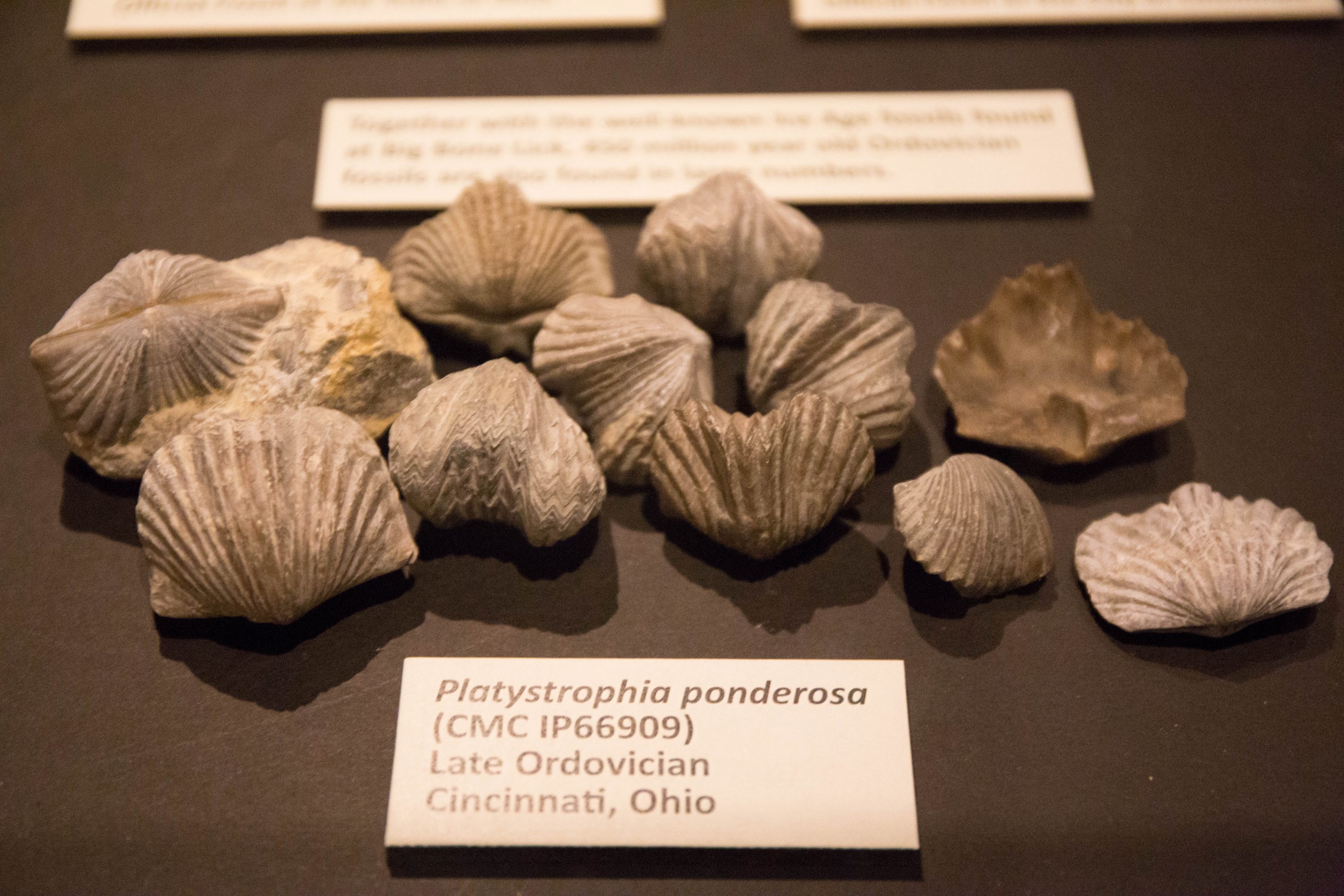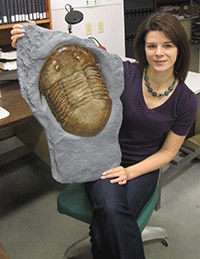
Invertebrate Paleontology
The Invertebrate Paleontology collection, 65,000 specimen lots housed in 4,500 sq. ft. of cabinetry, focuses on fossil invertebrate taxa from mid-continental North America, with particular emphasis on the middle Ohio Valley (Ohio, Kentucky, Indiana). Stratigraphically, this area covers Middle Ordovician through Upper Carboniferous (Pennsylvanian) as well as Quaternary sequences. The collection of Upper Ordovician fossils, focusing on the uniqueness of the Cincinnati succession, is the world's largest and is unequalled in its scope and quality. Significant research material from other regions and ages are also included in the collections.
The strengths of this collection include Lower to Middle Paleozoic invertebrates of central North America, particularly those of the Cincinnati Arch region (Ohio, Kentucky, Indiana). Specimens of Late Ordovician age, particularly those from the "type Cincinnatian” are especially significant. Other notable components of the collection are the Paleozoic echinoderms of the Max J. Kopf Collection, Budenbach (Hunsrückschiefer) fossils, Burgess Shale specimens from Charles D. Walcott and Kenneth E. Caster, Devonian corals from the Falls of the Ohio, the Burlington (Iowa) crinoid types of Samuel A. Miller and William Gurley, and a collection of South American invertebrate fossils (including types) acquired by Kenneth E. Caster and others. The type Ordovician trace fossils of R. G. Osgood Jr. are in the collection, as are the trilobite ontogenetic series of Hu Chung-Hung, a cast set of European Homalozoa and primitive echinoderm types (notably of Bohemia) and casts of Himalayan trilobite types (the only set outside of India).
Currently, the collection is strongest in specimens from the Cincinnatian Series and includes more than 66,000 specimen lots, of which over 60,000 are paper catalogued. Large, significant Ordovician collections have also been acquired from sites in Canada and New York. In addition, there are over 5,000 type and figured specimens in the collection, most of which are listed in two published type catalogs (Chappars, 1936; Hansman, Shaw and Pettyjohn, 1962). Type specimens feature the materials of Samuel A. Miller, Rousseau Flower, Kenneth E. Caster, August F. Foerste, Richard G. Osgood Jr., Colin D. Sumrall and many others.
Paleobotany Collection
The Invertebrate Paleontology collection also houses a paleobotany collection, containing approximately 1800 specimens. The collection is dominated by a variety of fossil plant species with nodular preservation from Mazon Creek, Illinois, and Terre Haute, Indiana. Mazon Creek is a Lagerstätte, a fossil locality that has an unusual set of depositional and preservational conditions that allows for the exceptional preservation of plant and animal material.
Meet the Curator
Dr. Brenda Hunda
Curator, Invertebrate Paleontology
Phone: (513) 455-7160
Fax: (513) 455-7169
Email: bhunda@cincymuseum.org
Biography

Growing up in Alberta — Canadian dinosaur country — was the perfect place to develop my fascination for fossils. Paleontology has been a life-long passion of mine, and going out on “dinosaur digs” in the badlands of Alberta as a teenager certainly had an impact. I went on to study paleontology at the University of Alberta in Edmonton, Alberta, Canada where I earned a B.Sc. in Honors Paleontology. I decided to stay at the University of Alberta but with a shift in focus from vertebrate to invertebrate paleontology. Trilobites became my research interest so I worked on Middle and Upper Ordovician trilobite biofacies and systematics from the Northwest Territories, Canada for my M.Sc. in Geology. I then made the big move to California, where I worked with Dr. Nigel Hughes on my Ph.D. in Earth Sciences at the University of California, Riverside. This researched focused on stratophenetic patterns and ontogeny of Flexicalymene (Trilobita) from the Upper Ordovician (Cincinnatian Series) of Ohio, Kentucky and Indiana. Because the fossils are so amazing in type area of the Upper Ordovician, when the opportunity arose for a chance at the Curator of Invertebrate Paleontology position at Cincinnati Museum Center, I took it. I have been the Invertebrate Paleontologist at Museum Center since 2004. My position includes exhibit design, educational programming development, community outreach in the form of lectures and workshops, curating the largest collection of Upper Ordovician fossils in the world, developing a research program and playing in the one of the highest diversity fossil sea bottoms in North America.
Education
- B.Sc. (Honors), Paleontology
University of Alberta, Canada, 1992-1997 - M.Sc., Geology
University of Alberta, Canada, 1997-1999
“Upper Ordovician Trilobites from the Southern Mackenzie Mountains, Northwest Territories, Canada” - Ph.D., Geology
University of California, Riverside, 1999-2004
“Flexicalymene (Trilobita) from the Cincinnatian Series (Upper Ordovician) of Ohio, Indiana, and Kentucky: A Case Study of Microevolutionary Pattern within a Single Species Lineage in a Sequence Stratigraphic Framework”
History of the Invertebrate Paleontology Collection
The paleontological collections represent the combined efforts of numerous predecessors and partner institutions in the Cincinnati area. They began under the guidance of prominent Cincinnati physician Daniel Drake and the Western Museum Society in 1818 and were continued by members of the Western Academy of Natural Sciences (1835), the Cincinnati Society of Natural History (1870) and the Cincinnati Museum of Natural History (1857). Samuel A. Miller was the first Curator of Paleontology of the Cincinnati Society of Natural History (1871-1874), followed by John W. Hall, Jr. (1874-1877), Edward O. Ulrich (1877-1880), John Mickelborough (1880-1884), Edward M. Cooper (1884-1885) and Charles L. Faber (1885-1886). Ulrich served as Custodian of the Scientific Department beginning in 1873. A comprehensive Geology Department was established at CSNH in 1886, and later divided into individual departments of invertebrate paleontology, vertebrate paleontology and mineralogy.
The University of Cincinnati Geology Museum paleontology collection was founded in 1907 and transferred to Cincinnati Museum Center in 1998. The university collection includes thousands of specimens collected by the Dry Dredgers Association of Amateur Geologists & Fossil Collectors, the oldest amateur paleontology association in the United States, founded in 1942. Educational and collecting efforts of Invertebrate Paleontology continue to be aided by a flourishing relationship with the Dry Dredgers. The entire collection was moved to its current location at the Geier Collections and Research Center facility in 2001. In 2004 the Curator of Invertebrate Paleontology position was endowed.
Geology and Mineralogy Collection
The Mineralogy Department collects mineral specimens (including gemstones) and rocks (including meteorites, geological structures and ornamental stones). The emphasis of the collection is on the display and educational potential of material occurring regionally throughout the Central Lowland Province of the United States, with secondary emphasis on other worldwide occurrences. The collection of 12-15,000 specimens is housed in a dedicated, secure room at the Geier Center in 1,160 sq. ft. of cabinetry and shelving.
The Mineralogy Collection also contains geology-related material, for example, mining artifacts (tools, lamps, analytical instruments, mining equipment and mining stock certificates). This material is used in exhibits, and in the educational interpretation of the collection and of temporary exhibits.
History of the Geology and Mineralogy Collection
During the late 1800s, the Cincinnati Society of Natural History maintained a mineralogy collection, and a few objects from this period can be identified within the current collection. Major periods of collection building, most notably the early 1900s, the mid-1940s to early 1950s, and the 1980s and 1990s have resulted from the influences of Charles Dury, Ralph Dury and the current Adjunct Curator of Mineralogy, Terry Huizing. Prior to the Museum’s move to Union Terminal, minerals were a major part of public exhibits in the Cincinnati Museum of Natural History. The current display in the Museum of Natural History & Science includes some particularly fine examples of tri-state minerals and those of importance to the national economy. Meteorites from the collection are used in the space/cosmology exhibit.
Staff and Adjuncts
Glenn W. Storrs, Ph.D.
Assistant Vice President of Collections and Research & the Withrow Farny Curator of Vertebrate Paleontology
Cincinnati Museum Center, Geier Collections & Research Center
1301 Western Avenue, Cincinnati, OH 45203-1130
Phone: (513) 455-7164
Fax: (513) 455-7169
Toll free: (800) 733-2077 Ext.7164
Email: storrsgw@email.uc.edu
Brenda Hunda, Ph.D.
Curator of Invertebrate Paleontology
Cincinnati Museum Center, Geier Collections & Research Center
1301 Western Avenue, Cincinnati, OH 45203-1130
Phone: (513) 455-7160
Fax: (513) 455-7169
Toll free: (800) 733-2077 Ext.7160
Email: bhunda@cincymuseum.org
Adjunct Staff
Carlton Brett, Ph.D.
Adjunct Curator of Invertebrate Paleontology
Professor, Department of Geology
500 Geology/Physics Building
University of Cincinnati
Cincinnati, OH 45221
Phone: (513) 556-4556
Fax: (513) 556-6931
Email: carlton.brett@uc.edu
David L. Meyer, Ph.D.
Adjunct Curator of Invertebrate Paleontology
Professor, Department of Geology
500 Geology/Physics Building
University of Cincinnati
Cincinnati, OH 45221
Phone: (513) 556-4530
Fax: (513) 556-6931
Email: david.meyer@uc.edu
Arnold Miller, Ph.D.
Adjunct Curator of Invertebrate Paleontology
Professor, Department of Geology
500 Geology/Physics Building
University of Cincinnati
Cincinnati, OH 45221
Phone: (513) 556-3732
Fax: (513) 556-6931
Email: arnold.miller@uc.edu

